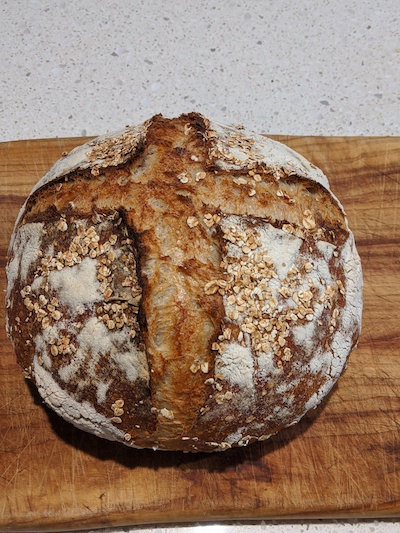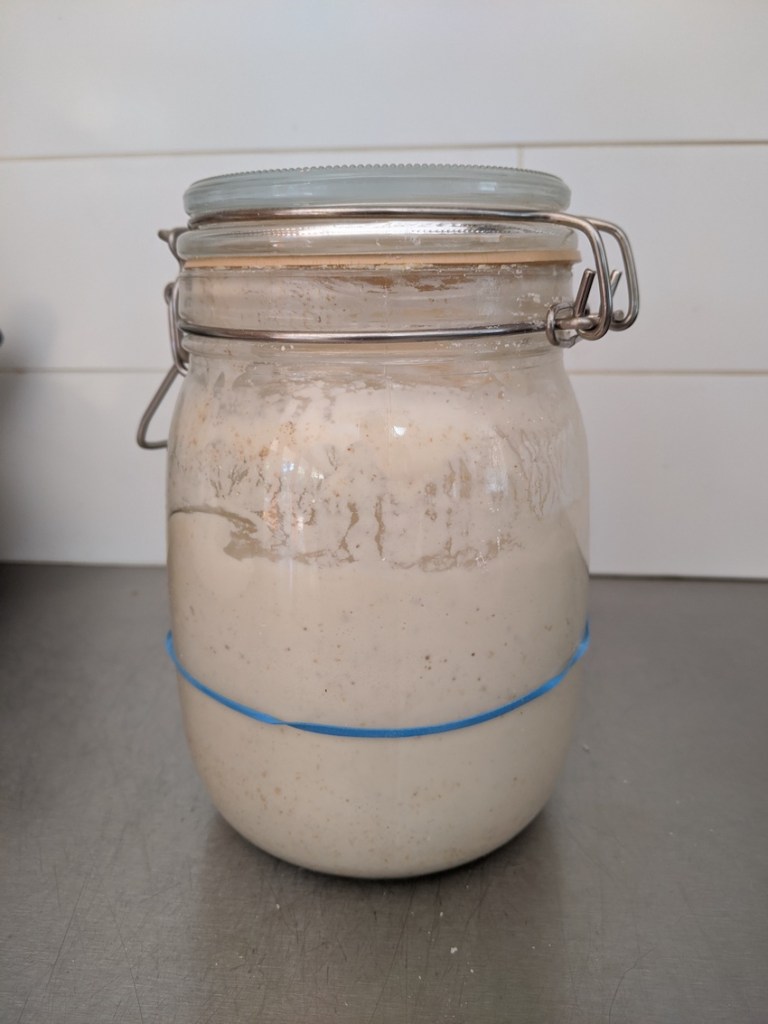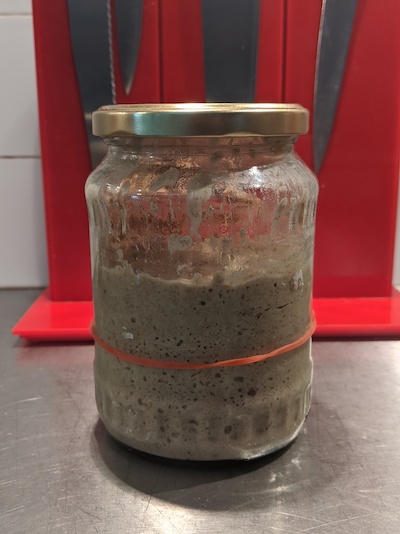Once the time has come that you make the leap from dry yeast bread baking to Sourdough Bread you need a Sourdough Starter or Sourdough Mother as some call it. Making your own Sourdough Starter is not all that hard, but it takes time and once ready you need to nurture the Starter by feeding it from time to time. Your patience will be rewarded once your first Sourdough Bread comes out of the oven, you will never go back to the dry yeast satchels you used before.
A Sourdough Starter is the rising agent of your bread. Sourdough is a living organism with a relatively short gestation time. Within a week your Sourdough Starter will be ready, alive and kicking for some miraculous Sourdough Bread recipes.
There are various ways of starting a Sourdough, this recipe uses sultanas for a very active starter.
How old the oldest Sourdough Starter is, is unknown but there are plenty of (home) bakers that have Sourdoughs that are over 100 years old. The older your Sourdough Mother the more flavour it will add to your bread. But no worries, your newly started Sourdough will add a punch of flavour too.
Who connected us?! This recipe is from The Bread Basket. I have been using and adjusting quite a few of their bread making recipes with great success.
Ingredients:
- 1 cup (160g) sultanas
- 2 cups (500ml) water
- 1 1/3 cups (200g) plain bakers flour
- 1/3 cup (50g) plain bakers flour
- 2 1/2 tablespoons water
Instructions:
- Put the sultanas in the water in a 1 litre container with a lid and let it rest for 6 days. You will see the water getting murky. After the 6 days you can see some sediment on the bottom and the water might smell slightly alcoholic which is a good sign as this means the fermentation process has started.
- Take out the sultanas from the water. Don’t trow them out but use them in a raisin bread, cake or muffins.
- Use 200ml from the water (if there is a lot of sediment filter the water). In a glass jar, mix the 200ml of water with 200g of flour with a chopstick or wooden spoon. Close the jar and leave it at room temperature for about 12 hours. You will notice that the mixture will rise and double in size. It might take longer when it is cold.
- When the starter is doubled in size, add the 50g of flour and 2 1/2 tablespoons of water and mix with a wooden chopstick.
- Leave for another 12 hours or until doubled in size.
- When you look at the bottom you will see air-bubbles have formed. Your Sourdough Starter is now active enough to be used and you can start on your very first Sourdough Bread.
You just made about 450g of Sourdough Starter. Most recipes use between 150 -300 grams of starter, which means that when you have taken out what you need for your bread, you have enough left to feed and use for your next loaf.
I have 2 active Sourdough Starters, one made from Bakers flour and the other made from Rye Flour, which give the bread a much deeper robust flavour.
Taking care of your Sourdough Mother
Your Sourdough Starter is a living thing and like anything else that is alive it needs some love to thrive and stay alive. But not to worry, keeping your starter alive is not as daunting as some might think. Although many would say that a daily feed is best, and rightly so, your starter will survive if you give it a little less attention. When you get into a feeding routine it will become really easy, and I will give you some tips that allow you to go on holiday too.
After your first use, make sure you have at least 150g Sourdough Starter left. Your starter is still young, so in the beginning give it a good feed. Add 100g of flour and 100g water and mix well. I use a chopstick. Leave it on the bench-top for a day and you will see new bubbles appearing which means your starter is very lively. If you are not using the Sourdough starter daily, which most of you won’t, keep it in the fridge and feed the starter every 3-4 days. A little feed of 50g flour and 50g water is enough and leave it at room temperature for a couple of hours until new bubbles form. Once your Sourdough is more mature after a month or so, you can even feed it less to keep it alive.
Half a day before you are going to bake, take the Starter out of the fridge and give it a good feed. Depending on the temperature, you will see your Starter getting active and doubling in size in about 4-6 hours.
Discharging some of the Sourdough Starter
When your Sourdough Starter gets too much you will have to discharge some, otherwise the ratio with your feeding gets unbalanced. Many recipes talk about discharging part of the Sourdough Starter regularly, but once you have a routine in feeding and baking, you will not really have to trow away any of your Starter. After all, when you bake a bread, you will use a at least half off the Starter and feed the leftover starter again.
In case you are not baking on a regular basis and you have some leftover starter. Don’t chuck it in the bin, but use some in a frying pan, bake like a thick pancake and you have yourself a nice piece of bread with some soup or pasta dish.
I make on average 2-3 loafs of bread combined weekly from the 2 different starters that I have and mine are still very active.
Notes:
- Metal: Try to avoid metal bowls and utensils. The metal can have an effect on the bacteria in the Sourdough, making it less active.
- Elastic band: A little trick I learned is to put an elastic band around the jar when you are feeding the Starter. You can then see how much the Starter has risen after a few hours.
- Holiday: Going away! You can freeze your Sourdough Starter for up to 3 months and revive it once you are ready for your next homemade Sourdough Bread.
- For more tips on feeding, storing and ultimately reviving you Sourdough Mother “How to feed and store my Sourdough Starter”
- What is the oldest Sourdough Starter?: It is not really known how old the oldest Sourdough Starter is but there are stories that some people have Sourdough Starters that are more than a 100 years old.
- Can an old Sourdough Starter make you sick?: Please, I am not a doctor, but when a Sourdough Starter is off and giving an awful spiritus like smell, it is not recommended to use it. A bad Sourdough will not bake good Sourdough bread anyway, so you will likely not use it anyway.
- How long can you keep a Sourdough Starter in the Fridge?: For more tips, go to this post “How to feed and store my Sourdough Starter”

Start making your own sourdough bread with one of these recipes




4 Comments Add yours